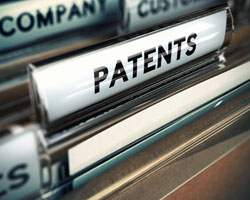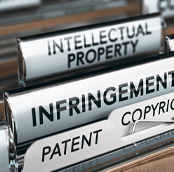Patents
 Recognizing the importance of promoting invention and providing protection to inventors, the framers of the Constitution specifically empowered Congress to enact laws granting patents “for limited times.” Under current law, a patent may be obtained for a 20 year period, but may not be renewed. The patent gives the owner “the right to exclude others from making, using or selling the invention throughout the United States.”
Recognizing the importance of promoting invention and providing protection to inventors, the framers of the Constitution specifically empowered Congress to enact laws granting patents “for limited times.” Under current law, a patent may be obtained for a 20 year period, but may not be renewed. The patent gives the owner “the right to exclude others from making, using or selling the invention throughout the United States.”
The Requirements for Patentability
To obtain a patent, you must demonstrate four things:
- That the subject matter of the invention is eligible for patent protection
- That the invention is novel
- That the invention is useful
- That the invention is non-obvious
The Subject Matter of the Patent
Under the patent laws, to qualify for a patent, an invention must be one of the following— a process, a machine, a manufacture or a composition of matter:
- A process patent covers the treatment of goods or materials to produce a specific result. For example, a water-based process for decaffeinating coffee may qualify.
- A machine patent provides protection for any device, usually with electrical or mechanical parts, that performs a useful operation
- A patent for the composition of matter simply involves the combination of two or more substances to produce a new product
- Manufacture patents offer a catchall for inventions that don’t fit the first three categories, such as envelopes, mouse-pads and gloves.
Specifically excluded from subject matter patentability are methods of doing business, scientific principles, mathematical algorithms, mental processes and naturally occurring articles.
The Requirement of Novelty
An invention may not be patented if it was known to the public before the date the patent application was filed. This prevents people from seeking to put patents on items that have been in common use. An invention may be novel if it contemplates an entirely new use of a known invention.
The Usefulness of an Invention
Patent law requires that an invention provide some identifiable benefit. Furthermore, it must be capable of being used. For example, you can’t get a patent on a time machine if you can’t use it to travel in time. When considering the utility of an invention, the patent examiner will look at (1) whether the invention works as stated (the legal terminology used is whether the invention is “operable”), (2)the specific benefits the invention offers or provides, and (3) whether there is any practical use for the invention.
Non-Obviousness
The requirement of non-obviousness simply looks at how significantly the invention has gone beyond existing patented inventions, and disqualifies obvious advances, so as to eliminate new patent applications every time there is a new use or improvement.
The New Law Governing Filing Patents in the United States
Effective March,2013, the United States amended the patent laws, changing from the prior concept of “first to invent” to a “first inventor to file.” Under previous law, the person who could demonstrate to the patent office (or eventually to the court) that he or she was the first to invent had an exclusive right to file a patent for a limited period of time.
Under the new law, the rules are far more complex, and almost encourage inventors to publicly disclose inventions. For example, if a person invents a device in January, but doesn’t file for a patent application until June, he or she may be denied patent protection against someone who came up with the same invention in February, but filed in May. Both parties must show that the inventions were independently conceived, but if they do, the only way the first inventor will have priority will be if the invention was publicly disclosed.
The Remedies for Patent Violation
If you have been the victim of patent infringement, you can ask the court to issue an injunction, prohibiting the infringing party from using, making or selling the infringing product. You can also seek monetary damages, including “reasonable royalties,” lost profits and the costs of litigation.
Connect with Top-rated Attorneys Near You
Sponsored Advertisement
Latest Article
The Differences Between Copyright and Trademark Protection
What Does Copyright Protect? What Is the Purpose of a Trademark? Over the past half century, intellectual property has ... Read More
What Does an Entertainment Lawyer Do?
The Legal Challenges Handled by an Entertainment Attorney You've put a band together and have been playing a lot of gig... Read More
GETLEGAL®ATTORNEY DIRECTORY
Find Leading Attorneys in Your Area
NEED PROFESSIONAL HELP?
Talk to an Attorney
How It Works
- Briefly tell us about your case
- Provide your contact information
- Choose attorneys to contact you





